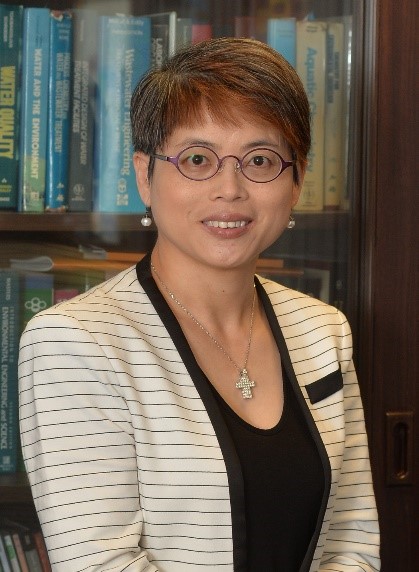
Ir Prof Irene M. C. LO
Academician, M.EASA, FASCE, FHKIE, CAP, JPSpeech Title: In situ photoelectrochemical activation of chloride in sewage by an optimized MoS2@BiVO4 photoanode for the simultaneous PPCPs degradation, H2 evolution and E. coli disinfection
Abstract: Pharmaceuticals and personal care products (PPCPs) are ubiquitous pollutants in sewage posing adverse effects on ecosystems and humans, and escherichia coli (E. coli) exists with high density in sewage which may cause several diseases to humans. Driven by solar-light, photocatalysis has been developed for both PPCPs degradation and E. coli disinfection. However, the disadvantages of severe secondary pollution caused by the suspension-type photocatalysts, low efficiency because of high charge recombination, and cannot produce high-value products to offset the treatment cost still hold back its practicability. Herein, we have developed a multifunctional photoelectrochemical (PEC) system for simultaneous PPCPs degradation, E. coli disinfection, and H2 evolution via in situ activation of chloride ions in sewage. To this end, we have synthesized MoS2@BL-BiVO4 photoanode (the photocatalyst was adhered on the conductive glass substrate) with high PEC performance via strategies of reducing bulk and surface recombination. 2 ppm benzophenone-3 and the E. coli in sewage can be completely removed by the PEC system using this photoanode in 30 minutes at 1.0 V vs. Ag/AgCl applied voltage under visible light illumination, simultaneously, 89.32 μmol H2 was produced as the byproduct. Moreover, the PEC system also showed high efficiency for the degradation of ibuprofen and carbamazepine. As a comparison, both electrocatalysis and photocatalysis showed low efficiency toward PPCPs degradation and E. coli disinfection, and cannot yield any H2. The mechanism study revealed that chloride ions in sewage were activated to be chloride-based radicals (•Cl, •ClO) for sewage treatment and reacted with holes to separate more electrons for H2 evolution. Suspension solids and natural organic matters are the main sewage components that impeded the PEC reactions since they can compete for active species with PPCPs and E. coli, and react with electrons. The cycling test revealed that the PEC system has excellent reusability and stability, guaranteeing its great practicability.
Biography: Ir Prof Irene Lo, JP is currently a Chair Professor in the Department of Civil and Environmental Engineering at The Hong Kong University of Science and Technology. She is an elected Academician of the European Academy of Sciences and Arts, elected Fellow of the Hong Kong Institution of Engineers, and elected Fellow of the American Society of Civil Engineers. She was appointed by HKSAR Government as Justices of the Peace (JP) in 2017. She was also Adjunct Professor of Tongji University, Tianjin University, Jilin University and Harbin Institute of Technology. She had been Visiting Professor of Technical University of Denmark and the University of Wisconsin at Madison.
She was the recipient of numerous prestigious international research awards, such as 2007 ASCE Samuel Arnold Greeley Award, 2009 ASCE Wesley W Horner Award, and the 2012 ASCE EWRI Best Practice-Oriented Paper Award. In addition, she received the 2019 Higher Education Outstanding Scientific Research Output Awards in the Natural Science/Technology Advancement by Ministry of Education, China. She has been invited to give over 50 plenary/keynote/invited speeches at many international conferences in Asia, Europe, Africa, and North America.
Her research interests include advanced oxidation processes and nanoparticles/nanotechnology for environmental applications. Her citation is 18040+ with H-index 74, as reported by Google Scholar. She was recognized as "Top 2% Scientists in the World” by Stanford university in 2020, 2021 and 2022.
